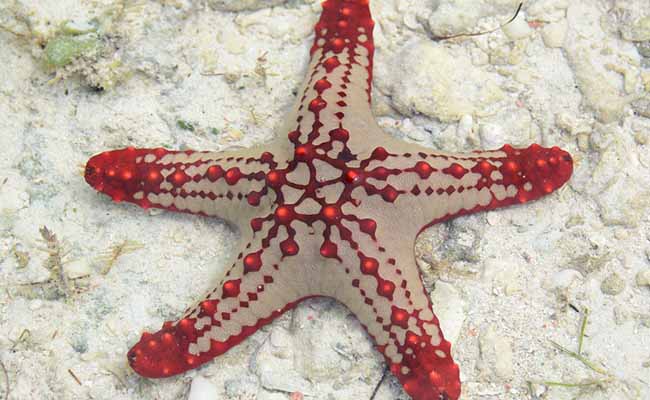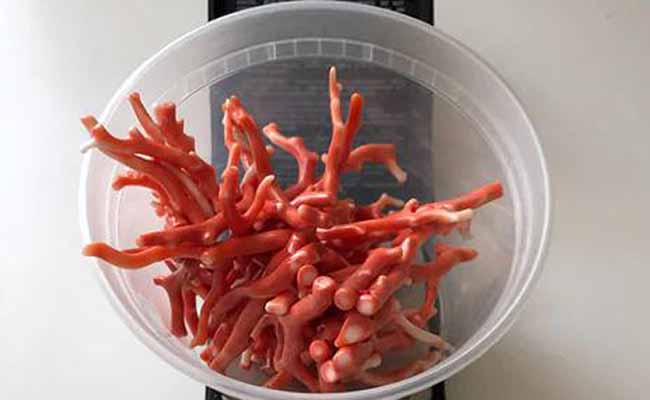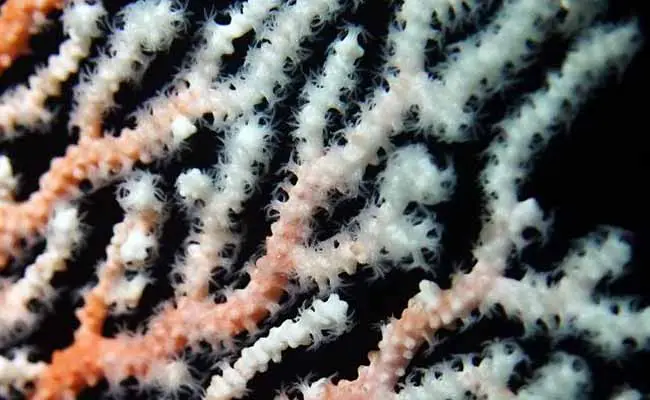The marine world is full of colors and stunning views. One of the most colorful aspects of this world is the colorful marine invertebrates. Precious corals are among such invertebrates. It’s worth to know about this color marine life. For that, you’ll learn about different types of colorful marine invertebrates, precious corals, and their most prestigious types. Moreover, the health issues and care of precious corals are also in the scope of this article.
Content Table

Colorful Marine Invertebrate
Land lacks many colors that are present in marine environments. Colorful invertebrates are examples of such full-of-life creatures. Marine invertebrates comprise a diverse group of organisms, which are as follows.
| Corals | Anemones | Sea Urchins | Sea Stars |
| Nudibranchs | Octopuses | Shrimp and Crabs | Jellyfish |
Here are some examples of colorful marine invertebrates.
Red-Knobbed Sea Star
| Protoreaster linckii is the scientific name of red-knobbed sea stars. These Indian Ocean natives have an almost 1-inch thick, grey body that has raised bright red tubercles on each arm. Each arm is attached to the center with a red line, which gives them a grid shape. The underside is also red and has pink feet and a central mouth.
These 12 inches creatures are often present at the sea beds. However, they can live up to 100 meters of sea depth. They are carnivores and feast on various invertebrates, soft corals, sponges, tube worms, clams, and other starfish. |
 |
Maxima Clam
| The scientific name of the maxima clam is Tridacna maxima. They are also known as small giant clams or Rugosa clams. They are distributed throughout the Red Sea to Eastern Africa and the tropical Western Pacific Ocean. They have concentric, wavy outer shells.
They love to live in shallow waters because they love intense sunlight. Moreover, they also require healthy reefs and good water flow. They get most of their food from zooxanthellae, i.e., photosynthetic dinoflagellates. |
 |
Red Fire Shrimp
| Red fire shrimp’s striking red color makes them eye-catching. Lysmata debelius is the scientific name of blood shrimp, cherry red shrimp, or scarlet cleaner shrimp. These natural cleaners are native to the Indo-Pasific oceans.
They live in crevasses and rocky areas within the coral reefs. They have thick L-shaped bodies. They can achieve a maximum 4-inch size. They eat various types of food as they are omnivores, i.e., meat and green. |
 |
Red Scarlet Hermit Crab
| Their red legs and reef-like tops make them colorful and unique marine invertebrates. This red-legged creature has Paguristes cadenati scientific name. They are native to the Caribbean and the west Atlantic oceans. They are usually present in reef faces and coral rubbles.
They have red legs, yellow faces, and reef-like backs. They feed on multiple foods, i.e., decaying organic matter, algae, detritus, and uneaten fish food. They live in the intertidal zone and are also present at the 260-foot depth of the ocean. More about Hermit crab. |
 |
Blue Velvet Nudibranch
| Chelidonura varians is the scientific name of the blue velvet nudibranch or head shield sea slug. This colorful marine invertebrate is native to the Red Sea and Indo-West Pacific Ocean. They are distributed around reefs, under decaying wood, and in silty and sandy regions. They are present up to 98 feet in depth.
As the name suggests, blue lines run around the black body and head. They have hammer-shaped heads and two tail-shaped appendages. Moreover, they have a trace amount of poison that they secret in hard times. They are predators and feast only on red planaria flatworms. |
 |
Red Ball Sponge
| Pseudoaxinella lunaecharta is the scientific name of red ball sponge or red boring sponge. These soft corals are ornamental marine invertebrates. They are native to the Western Atlantic Ocean, Florida, and the Caribbean regions. They are distributed from a few feet depth to several hundred feet depth, from onshores to off-shores.
They have spherical bright red or orange color shapes. They don’t attach to the rocks and seafloor. They feed on microscopic food, dissolved organics, bacteria, and liquid Plankton. |
 |
What Is a Precious Coral?
Precious coral is a type of marine coral with a hard and durable skeleton with red or pink coloration. They are branching cnidarians that have been present at several hundred meters depth at sea level under high pressure for thousands of years. They are endo-planktons that are harder than the exo-planktons. They are used as jewelry, idol making, medicine, and beautiful beads.
Types of Precious Corals
There are 7,300 different coral species. Out of all, only 10 are top precious corals. These corals get their food from the algae, i.e., zooxanthellae that grow inside the corals. These 10 types are as follows.
Oxblood
| Aka and Moro are the other common names of this rare precious coral. These are present in Japanese waters, with dark-red to intense dark-red coloration, and have a white interior. This white interior is often known as the soul. These 200-gram corals are present at 300 meters of ocean depth. They have fan shapes with 20 cm height and 12 cm trunk diameter. |  |
Cerasuolo
| Momo and Satsuma are other common names for these Japanese and Taiwan native precious corals. They are also fan-shaped corals with 35 cm height and the same trunk diameter with a 500 grams weight. They are present at 150 to 350 meters in depth. |  |
Magai
| Boké and Angel Skin are the common names for Japanese and Taiwan native Magai precious corals. They are fan-shaped corals with 35 cm in height and 25 cm in trunk diameter with 500 gram weight. These delicate flesh-pink corals grow at 150 to 350 meters of ocean depth. |  |
Pure White
| Shiro is another name for pure white precious corals. As the name suggests, they are milky white and have pink or red specks. They grow like a fan shape and achieve 35 cm height and 25 cm trunk diameter. They grow at 80 to 300 meters depth in Taiwan and Hainan waters. |  |
Rosato
| Rosato are the white precious corals with red or uniform clear-pink specks. They grow at 400 to 600 meters depth in Hawaii and Midway Island. These corals can achieve 25 cm height and 15 cm trunk diameter. |  |
Shinkai
| Shinkai comes in bright white and white pomegranate color with red veins and a clear pink shade. They are also known as the deep sea because they are present at 1,000 to 2,000-meter depth of Midway, northwest of Emperor Seamount waters. They can gain 30 cm height and 10 cm trunk diameter with 150 grams of weight. |  |
Garnet coral
| These precious corals are pomegranate colors with different shades of pink. These corals grow at 350 to 600-meter depth in Hawawii waters. They can grow 15 cm in height and 6 cm in trunk diameter with a parallel shape. However, their harvesting had been stopped due to the high operational costs for 1980. They can live up to 3 – 8 years. |  |
Misu
| Misu is often known as Missu or Miss Corals. They come in violet to pink color. They usually grow at 100 – 300 meter depths in Japan, Taiwan, and the Philippines waters. They grow in long-shape with 25 cm height, 15 mm trunk diameter 200 gram weight. They can live up to 5000 years. |  |
Sardinian
| They are the most popular precious corals. The Mediterranean is another common name for Sardinian corals. They have signature medium to strong-red coloration. They grow in bush-shape at 60 to 1000 meters depth in the Mediterranean and North African Atlantic Oceans. They achieve 15 cm height, 8 mm trunk, and 100 grams weight. They can live up to thousands of years. |  |
Sciacca
| They come in pink, dark smoky orange, and orange color. They grow at various depths in Sicily’s waters, especially the coast of Sciacca. They have broken branches or trunks with 7 – 10 cm in height and 4mm in diameter. |  |
Precious Corals Careness
Corals and precious corals both can face health issues. There are many reasons behind these health issues, i.e., biological stress and non-biological stress. Biological stresses include bacteria, fungi, and viruses. Non-biological stresses include increased sea surface tension, ultraviolet radiations, and especially pollutants.
Common Dieseas for Precious Corals
Corals are affected by many health issues. Some of the common health issues are the following. Moreover, how to cure these diseases.
Stony coral tissue loss disease (SCTLD)
It’s a lethal coral disease that causes tissue loss and a higher mortality rate. Chlorinated epoxy and amoxicillin paste helps to cure it.
Brown Jelly Disease
It affects the coral’s surface. It makes a layer of brown jelly on the surface. Hydrogen dip, iodine dip, and removing the affected area help to recover your coral.
Black Band Disease
This is a common coral infectious disease. It attacks the surface, causes tissue loss, and spreads around the coral. It results in coral death. You can care for your precious coral with antibiotics. Moreover, it’s wise to quarantine it.
Coral Bleaching
The loss of zooxanthellae algae from the coral causes this coral health issue. It turns the coral into white. Algae loss happens due to different stresses, i.e., light and temperature fluctuation. To cure from bleaching, you need to maintain the temperature and light fluctuation.
Tissue Loss
This disease causes tissue loss in precious corals. This tissue loss leads to the death of corals. Bacterial pathogens and various environmental stresses cause this issue. To take care of your coral, quarantine them, stabilize the water and other parameters, and use some antibiotics.
Necrosis
Necrosis is another health issue for precious corals. The coral receives a physical injury and turns black or discolored. It spreads promptly. Therefore, you need to address it instantly. Otherwise, it leads to the death of coral. To avoid physical damage, emphasize smart fishing techniques or reduce the fishing in the precious coral regions. Moreover, you can preserve the coral site by giving it to UNESCO.

The Value of Precious Coral
Precious corals are significant in various aspects. Some of them are as follows.
Economic Value
These precious corals are hard and durable because they grow under high hydrostatic pressure for a long time. Moreover, their colors make them attractive and highly valued in the jewelry and decorative industry. They are used in necklaces, earrings, bracelets, etc. Exporting these precious corals brings the capital into the region and results in economic prosperity.
Cultural Association
Precious corals are deeply attached to the cultures of specific regions and at different times. They have deep cultural roots in the Mediterranean and Indian regions. They are used in adornment, religious ceremonies, idols, etc. Moreover, they were also a symbol of status and wealth in history.
Ecological Preservation
Coral reefs exhibit a diverse biodiversity, i.e., 25% of marine life lives around these corals. So, as the precious corals. They contribute to the overall marine health and maintain the ecosystem. Therefore, protecting them will help to preserve the marine environment.
Coastal Preservation
They play a pivotal role in coastal preservation. Coral reefs absorb high wave energy and reduce it to a safe limit. In that way, our cost keeps their shape.
Recreational Spots
These precious coral sites promote tourism in the region. They attract people around the globe for different recreational activities, i.e., snorkeling, eco-tourism, diving, and scuba diving. These activities elevate the local businesses and generate revenue for coastal communities.
Research
Precious corals are also valuable for scientific and medical studies. Researchers study these corals for their growth patterns, ecological impacts, and reproduction behavior. Moreover, researchers have also found anti-inflammatory and anti-cancer properties in these corals.

The Final Word
Colorful marine invertebrates fill any space with unique colors. Among different types of colorful invertebrates, precious corals are the most interesting. Their resilient nature and the vibrant colors of different precious corals give them a lot of value in different aspects. However, these corals can have multiple health issues. Therefore, the care of the precious coral is mandatory.


Leave a comment